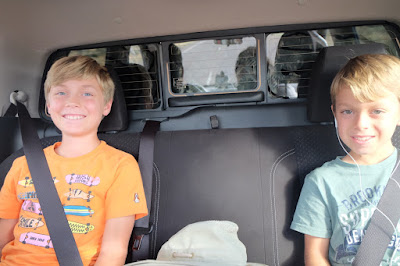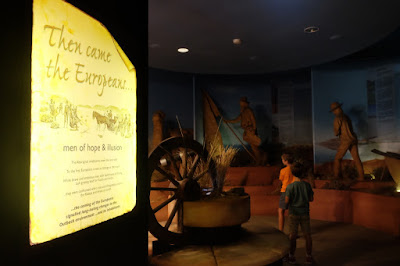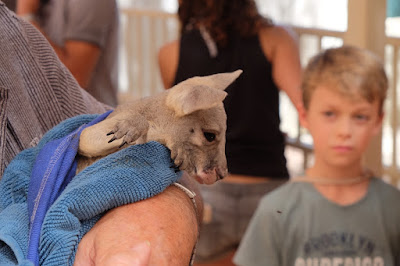We piled in the camper and off we went! Our first stop was just outside Adelaide in the Clare Valley, one of the most famous wine-producing regions of Australia. We popped in to Sevenhill Cellars, which was the first winery established in the area. Started by the Jesuits in 1851 in order to produce sacramental wine, the winery now produces table wines and all profits are put back into Jesuit-run programs that benefit needy people in local communities.
We tried a few of their wines and found we liked their whites and fortified wines (ports) the best.
While we tasted wines and took a quick peek into the cellar, the boys played outside in a large grassy space that had games and toys available for them to use.
After our tasting was done, we had a picnic where Colin again demonstrated his unique way of eating carrots. He eats them kind of like corn on the cob and saves the inside carrot core for last.
As we left the Clare Valley, the landscape started to quickly change.
We arrived in Port Augusta with enough daylight left to set up our camper for the first time. The boys and I were excited to see how this thing was going to work (Bob had already done this process once while picking it up), and both boys wanted to help get it ready.
Basically, the camper part opens up using a winch to flip the top of the silver box over 180 degrees. The top becomes the base of a platform that up to 3 people can sleep on, and when it opens it pulls a full size tent over the whole camping space. This is what it looked like when it was set up for camping.
These pictures were actually taken at our last stop, but they give a good idea of what the camper looks like opened up.
This is looking into the camper from the back. When it was open, there was enough room to stand up inside and wash dishes in the camp sink.
Once the top is opened up, there are also 2 almost full size cot-hammock things (those were perfect for the boys to sleep in). You can see one above the sink here, the other was behind me in this photo.
Here's a video tour of the camper!
The first night we went to bed excited to try out this camper. Colin didn't want to sleep in a cot, so he slept on the cushioned platform with Bob and me. Colin's a bit difficult to sleep next to, so in the middle of the night I decided I'd had enough and started to crawl over him and Bob to move instead to the empty cot. All of a sudden, Bob bolted upright screaming, "There's a wild animal in the tent! There's a wild animal in the tent!" We all jolted awake, in the pitch black dark, and tried to figure out what was going on. A few confused minutes later, we confirmed there was no "wild animal in the tent"...apparently I hit Bob's leg while moving and he thought I was an animal of some kind. It was pretty hysterical, and it will definitely remain a family joke for years to come.
The next day we visited the Wadlata Outback Centre, which was a fantastic introduction to the people, animals, and history of the Australian Outback. We watched videos of Indigenous Australians (Aboriginals) showing how they make wooden bowls and spears, how they cook a kangaroo, and explaining the traditional stories of the origins of certain constellations.
We learned all about the European explorers who traversed the Australian Outback, including Charles Sturt, who was so convinced there was an inland sea that he dragged a boat with him for his entire journey.
We learned about historical life in the outback, including pedal-powered radios for communications (and for learning with the School of the Air, which provides remote schooling for children scattered across the Outback) and switchboards that were part of the Australian Overland Telegraph.
After the Outback Centre, we made a quick visit to the Royal Flying Doctor Service base at the Port Augusta airport. This incredible service provides emergency and routine care to communities and tourists across the less-populated areas of Australia. They have a tourist center in Alice Springs, but we were able to see one of the actual bases, including the inside of one of the planes, and talk with a friendly lady about the history of the service and the medical care that the Royal Flying Doctors provide to thousands of people, many of them in incredibly remote locations.
After an interesting morning in Port Augusta, it was time to head out into the "true" Outback via Stuart Highway!
We had a bit of a drive ahead of us to get to Coober Pedy that evening. Our final destination, about a week later, would be Alice Springs--almost right in the middle, north to south, of the Australian continent.
There were a lot of these signs on the road, as the most common cause of injury/death to tourists is hitting animals on the desolate Outback roads (usually at dusk or dawn).
As we drove Stuart Highway, we passed a lot of white lakes. Unlike the deep blue and pink lakes we'd seen in Melbourne and along the Great Ocean Road, these are lakes in which the water has evaporated, leaving behind high concentrations of salt. There were a lot of them scattered about!
We passed some pretty desolate rest stops....
...we saw wild emus(!).........
...and a lot of road trains. These monstrous tractor-trailers have 2, 3, or even 4 trailers attached, one behind the other. They are both impressive and intimidating, especially on a two-lane highway.
We stopped briefly in Woomera, a town that sprang up as part of the Woomera Test Range, where the Royal Australian Air Force used to test weapons. Until the late 1990s, this place was booming with an international population working on weapons testing.
There was a small display of rockets that the boys found very interesting.
What I found both interesting and a bit eerie was the lack of people in Woomera. The range is still being used by different agencies and private companies, but the number of people has dramatically declined since the '90s. We saw housing, an elementary school, and other facilities that clearly looked used, yet there was nobody around. We saw one guy walk past in a military uniform, but other than a few tourists like ourselves and one lady running the small town museum, that was it. It was like being in a ghost town, only from everything we read the town was still inhabited. It was bizarre.
We drove down a few residential streets and we couldn't decide if the houses were abandoned or still being lived in.....it was really kind of eerie.
We got back on the road and Bob made a quick pop into our first of many roadhouses, Spud's. These roadhouses are part gas station, part restaurant, part lodging, and they are sometimes a town in and of themselves.
We off-roaded a bit to see Lake Eyre, the largest lake in Australia when it fills up. When it does, it has the same salinity as the ocean and so a tremendous amount of salt is left behind when the water evaporates.
We stopped for gas in Glendambo, whose population increased by over 10% when we arrived.
There was a road train pulled over, which gave me a good opportunity to get a closer picture of one of these monster vehicles.
Back on the road after getting gas and a cold drink, we had a bit longer to drive until we got to Coober Pedy.
We pulled into Coober Peby just as the setting sun gave us a beautiful Outback show.
The next morning in Coober Pedy, the boys had already made new friends at the campground, so they sat around talking at breakfast.
Coober Pedy is a quirky, unforgettable place. Life, fortunes, and tourism in Coober Pedy center around opals, which were first discovered in the area in February 1915. There are signs all over warning of open mine shafts, and there are piles and piles of dirt that have been brought up from deep underground. Another thing that makes Coober Pedy so unique is that many of its residents actually live underground due to temperatures that can reach up to 50 C/120 F in the summer months.
We started at the Old Timer's Mine, where we learned all about how opal mining works, walked through an old mine, and saw an underground home that was used until recently.
The first part of our visit was a demonstration of how a blower works. This is a machine that vacuums up dirt from within an opal shaft, clearing the shaft for the opal miners. The guide explained how the machine worked and then let everyone experience the suction power of the blower by putting in a handful of dirt themselves.
The current-day blower replaced earlier attempts, such as this first blower that was used for only 2 days before it quit working.
Inside the old mine, we learned about the conditions for the early miners and how they would crawl through spaces, sending leather buckets of dirt back up to the surface.
Miners often worked their own shafts, and they'd dig their way down from the surface. This is looking back up at the sky from deep within the opal mine.
The Old Timer's Mine also had an eclectic collection of memorabilia, publicity, and artifacts from earlier times in Coober Pedy, including this drive-in movie projector.
Television only came to Coober Pedy in 1980!
One of the most interesting parts was seeing an example of an underground home. This one was lived in until recently (early 2000s, I think).
When the owner's family outgrew the original home, he just dug a new room out for his daughter.
This display showed how early miners had safes underneath their beds to keep their opals hidden.
There was even a local post office underground here at one point!
Outside, the boys were able to "noodle" for their own opal pieces. "Noodling" is what it's called when you dig for opals!
Afterwards, we went to Josephine's Gallery & Kangaroo Orphanage, where indigenous art is sold and the gallery owner cares for injured and rescued kangaroos. First the boys tried playing didgeridoos with an artist in residence.
Colin was able to make a few sounds!
Then we went outside to meet the rescued kangaroos, who are rehabilitated and cared for by the gallery's owner. Many were hit by cars, or were orphaned when their parent was hit by a car.
There was a tiny joey who'd been brought in after he was found in his Mom's pouch.....unfortunately she had been killed by a car, but fortunately the joey was able to be saved.
Somewhat ironically (I didn't even realize this until just now), we went across the street and had pizza--including one with grilled kangaroo.
While eating lunch, we ended up chatting for a long time with Duncan, a local guy who runs the tourism information center. He was as interesting as Coober Pedy, with an oversized personality that seemed to be a perfect fit for this quirky town. He told us all kinds of stories about the town, including more about how the underground homes work. It's now illegal to mine within the town of Coober Pedy, but building an underground home (or extending an existing one) is legal. And any opals found while constructing or expanding your underground home are yours to keep. So, if you can get your underground home and/or its extensions approved, you can legally build (i.e., mine) within the city. So many people keep "expanding" their homes...Duncan told us there's one guy who has 4 wine "cellars" and who is running out of names for his various extension rooms.
Duncan also pointed us in the direction of the public noodling site, which is open to anyone and safe because there are no mine shafts. We stopped by the local hardware store to get a couple of shovels, and the boys were giddy to go noodling. As we walked, they planned out all the things they were going to buy when they both struck it rich on opals.
We all got into the noodling, and while we did find some opal shards and rocks with some opal in them, none of us struck it rich in Coober Pedy...guess we still need to work on finding new jobs for when this trip is soon over.
Around the corner from the public noodling site was the Catacomb Church, also underground.
The altar was made out of an old winch and bucket that were used to pull dirt out of an opal mine.
The pastor gave us a short explanation of the church and some of its features. He also took this funny photo of the four of us (and him) with the old mine shafts above us.
We ended our full day in Coober Pedy with a drive out to the Breakaways, a protected area about 30 minutes north of Coober Pedy. Sometimes referred to as Australia's Painted Desert, the colors of the land (and sky) were beautiful to see. 70 million years ago, this area was completely covered by water.
We saw the Dog (or Dingo) Fence, which is the world's longest fence and one of the longest structures in the world (even longer than the Great Wall of China). Constructed to keep dingoes out of South Australia and away from the state's valuable livestock populations, the fence is 5,614 km (3,488 miles) long.
As the sun sank lower in the sky, it was beautiful to watch the colors of the Breakaways change.
The sky turned shades of pink, purple, and red as the sun finally set. It's hard to capture the vibrancy of the colors in pictures, but it was stunning.
And as we headed back to Coober Pedy for one more night, we were treated again to an amazing Outback sunset!






































































































No comments:
Post a Comment